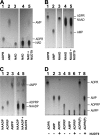Ruling out pyridine dinucleotides as true TRPM2 channel activators reveals novel direct agonist ADP-ribose-2'-phosphate
- PMID: 25918360
- PMCID: PMC4411260
- DOI: 10.1085/jgp.201511377
Ruling out pyridine dinucleotides as true TRPM2 channel activators reveals novel direct agonist ADP-ribose-2'-phosphate
Abstract
Transient receptor potential melastatin 2 (TRPM2), a Ca(2+)-permeable cation channel implicated in postischemic neuronal cell death, leukocyte activation, and insulin secretion, is activated by intracellular ADP ribose (ADPR). In addition, the pyridine dinucleotides nicotinamide-adenine-dinucleotide (NAD), nicotinic acid-adenine-dinucleotide (NAAD), and NAAD-2'-phosphate (NAADP) have been shown to activate TRPM2, or to enhance its activation by ADPR, when dialyzed into cells. The precise subset of nucleotides that act directly on the TRPM2 protein, however, is unknown. Here, we use a heterologously expressed, affinity-purified-specific ADPR hydrolase to purify commercial preparations of pyridine dinucleotides from substantial contaminations by ADPR or ADPR-2'-phosphate (ADPRP). Direct application of purified NAD, NAAD, or NAADP to the cytosolic face of TRPM2 channels in inside-out patches demonstrated that none of them stimulates gating, or affects channel activation by ADPR, indicating that none of these dinucleotides directly binds to TRPM2. Instead, our experiments identify for the first time ADPRP as a true direct TRPM2 agonist of potential biological interest.
© 2015 Tóth et al.
Figures







Comment in
-
Activators of TRPM2: Getting it right.J Gen Physiol. 2015 Jun;145(6):485-7. doi: 10.1085/jgp.201511405. Epub 2015 May 11. J Gen Physiol. 2015. PMID: 25964430 Free PMC article. No abstract available.
Similar articles
-
Identification of direct and indirect effectors of the transient receptor potential melastatin 2 (TRPM2) cation channel.J Biol Chem. 2010 Sep 24;285(39):30091-102. doi: 10.1074/jbc.M109.066464. Epub 2010 Jul 22. J Biol Chem. 2010. PMID: 20650899 Free PMC article.
-
Nicotinic acid adenine dinucleotide phosphate and cyclic ADP-ribose regulate TRPM2 channels in T lymphocytes.FASEB J. 2006 May;20(7):962-4. doi: 10.1096/fj.05-5538fje. Epub 2006 Apr 3. FASEB J. 2006. PMID: 16585058
-
Regulation of TRPM2 by extra- and intracellular calcium.J Gen Physiol. 2007 Oct;130(4):427-40. doi: 10.1085/jgp.200709836. J Gen Physiol. 2007. PMID: 17893195 Free PMC article.
-
TRPM2: a calcium influx pathway regulated by oxidative stress and the novel second messenger ADP-ribose.Pflugers Arch. 2005 Oct;451(1):212-9. doi: 10.1007/s00424-005-1446-y. Epub 2005 Jun 11. Pflugers Arch. 2005. PMID: 15952035 Review.
-
New molecular mechanisms on the activation of TRPM2 channels by oxidative stress and ADP-ribose.Neurochem Res. 2007 Nov;32(11):1990-2001. doi: 10.1007/s11064-007-9386-x. Epub 2007 Jun 12. Neurochem Res. 2007. PMID: 17562166 Review.
Cited by
-
A structural overview of the ion channels of the TRPM family.Cell Calcium. 2020 Jan;85:102111. doi: 10.1016/j.ceca.2019.102111. Epub 2019 Nov 24. Cell Calcium. 2020. PMID: 31812825 Free PMC article. Review.
-
Synthesis of phosphonoacetate analogues of the second messenger adenosine 5'-diphosphate ribose (ADPR).RSC Adv. 2020;10(3):1776-1785. doi: 10.1039/C9RA09284F. Epub 2020 Jan 9. RSC Adv. 2020. PMID: 31934327 Free PMC article.
-
ADP-Ribose Activates the TRPM2 Channel from the Sea Anemone Nematostella vectensis Independently of the NUDT9H Domain.PLoS One. 2016 Jun 22;11(6):e0158060. doi: 10.1371/journal.pone.0158060. eCollection 2016. PLoS One. 2016. PMID: 27333281 Free PMC article.
-
The role of TRPM2 channels in neurons, glial cells and the blood-brain barrier in cerebral ischemia and hypoxia.Acta Pharmacol Sin. 2018 May;39(5):713-721. doi: 10.1038/aps.2017.194. Epub 2018 Mar 15. Acta Pharmacol Sin. 2018. PMID: 29542681 Free PMC article. Review.
-
Molecular Regulations and Functions of the Transient Receptor Potential Channels of the Islets of Langerhans and Insulinoma Cells.Cells. 2020 Mar 11;9(3):685. doi: 10.3390/cells9030685. Cells. 2020. PMID: 32168890 Free PMC article. Review.
References
Publication types
MeSH terms
Substances
Grants and funding
LinkOut - more resources
Full Text Sources
Other Literature Sources
Molecular Biology Databases
Research Materials
Miscellaneous

